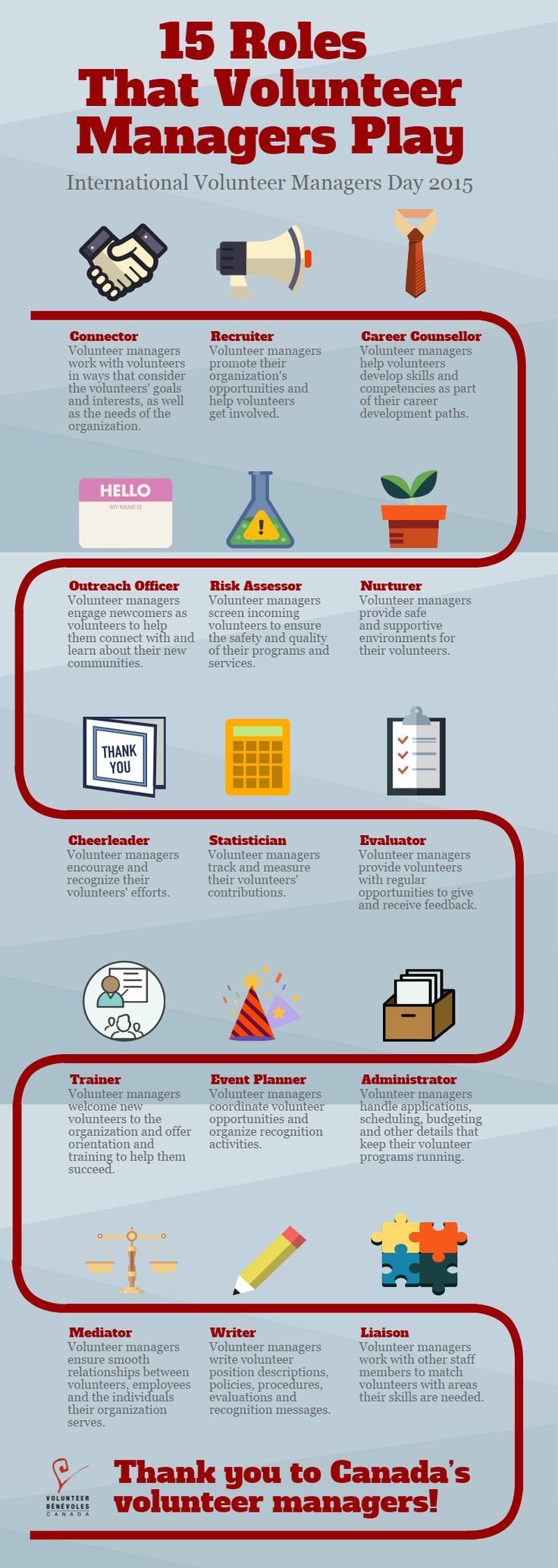In most cases, the person responsible for volunteer involvement finds and prepares volunteers, but then day-to-day supervision and teamwork occur at the front line between volunteers and the paid staff in each department and unit. So a key role of volunteer management is serving as an intermediary. Depending on the situation, this role can be consultant, educator, liaison, advocate, advisor, arbiter, or cheerleader.
Certainly implies a lot of different skills, doesn't it?
Part of the challenge is balancing the needs and perspectives of a range of stakeholders.
Volunteers
Volunteers are obviously the stakeholders who come to mind first - although it doesn't hurt to keep reminding your colleagues that volunteers are not "yours"; they are everyone's responsibility. And if anything, you are their liaison.
The volunteer office is the point of entry into the organization for all volunteers. We're the people they usually meet first and they form their opinions and expectations of volunteering from us. We "enroll" them and - just as a human resources department does for employees - we interview and orient them, keep their records, track their progress, and more. If any disagreement occurs between volunteers and the employees to whom they are assigned, the volunteer office is the most logical third party to involve in the resolution of the problem.
We have an obligation to any volunteer to be an advocate, willing to challenge paid staff if that volunteer is not treated well. We start this advocacy when we advise on creating volunteer assignments that are truly meaningful. But we also have the obligation to give a volunteer honest feedback if that person is contributing to a conflict. We are also the ones who should monitor that all volunteers are growing and thriving in their roles, when they deserve recognition, and when they might need or want to move into another type of assignment.
We must also give volunteers the chance to speak for themselves. Forming a genuine advisory council or steering committee of representative volunteers shares ownership and creates allies in talking to all the other stakeholders in the organization.
Paid Staff Who Work with Volunteers
Clearly, we also have a responsibility to the employees who have been asked to partner with volunteers. This begins with recruiting the best and most-qualified volunteers possible and preparing them to hit the ground running once placed in a unit.
It's vital to be a good listener in our role of intermediary with paid staff - and not to become defensive when we hear comments that are based on inaccurate or unknowledgeable assumptions. We have to empathize with employees who, almost by definition in most organizations, are overworked (and often underpaid) and to whom volunteers may offer help but also - let's be honest - more work, too. How can we adapt to the employee's needs when legitimate, such as paying attention to times during the week that a volunteer may be more a distraction than assistance? Or is it fair to ask the same staff person to keep training a parade of new volunteers when we might create a leadership role for an already-experienced volunteer to welcome newcomers?
More than anything, when it comes to employees, we are educators. So few professions include courses on working with volunteers in professional/academic education. Staff may not even know what they don't know about volunteers! The volunteer resources manager has to provide formal training to new staff and in-service training to all staff but, most critically, must find opportunities to consult with individual employees to improve their volunteer management skills as situations arise in daily work.
Middle Management Holding Frontline Staff Accountable
Middle managers - unit supervisors, program coordinators, branch directors, etc. - could be considered the invisible obstacle to successful volunteer/staff relations. Why? Because they are very important yet usually overlooked at several key stages of volunteer engagement. The leader of volunteers should ensure that:
- Middle managers participate in developing and sign off on volunteer position descriptions in their area of responsibility.
- Middle managers see the time their reports spend with volunteers not as an interruption or distraction from their work, but as vital to accomplishing priorities.
- Both overt and implied messages middle managers give to their paid and volunteer staff members in unit meetings convey the value of volunteers.
- Middle managers themselves partner with volunteers in getting their own work done - and are thanked for this teamwork.
Top Administration (Including the Volunteer Board)
We understand the importance of the executive and board of directors as those "above" us -- the ones who make key decisions, allocate resources, determine priorities, and judge our effectiveness. But what about our importance to them?
Depending on the size of your organization, top executives and the board may be quite removed from seeing the daily impact of non-board volunteers and completely unaware of the contributions of the volunteer office to the process. Is the subject of volunteering on the agenda at any management team or board meeting? Based on what information? Have you asked to present at such a meeting?
Volunteer resources managers once again must be advocates to bring attention to volunteers as time donors, highlighting the importance of donated skills in the spectrum of other community support and side-by-side with financial gifts. We must speak the language of the organization's decision makers, not simply as cheerleaders (though enthusiasm is important) but as representatives of an in-house treasure trove of great talent.
The Recipients of Service
Different organizations take varying approaches to their clientele, but all too often the services offered to those clients are determined solely by the paid staff or funding source. That does not need to be the way volunteer services are provided. We can talk with as well as to the recipients of service to assure volunteers that what they are doing is truly of help. We can even enlist the clients themselves - or past clients or client families and friends - as volunteers, when appropriate. And if we have our finger on the true pulse of client wishes, think how useful our knowledge can be to every one of the stakeholder groups above!





